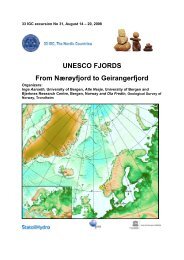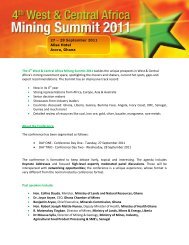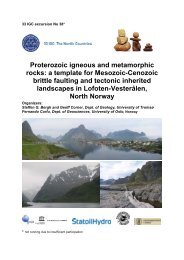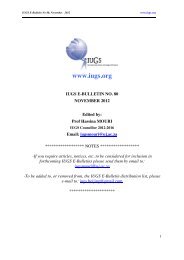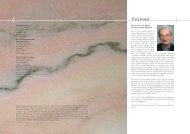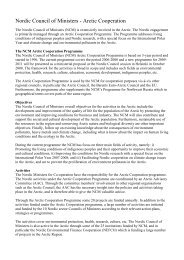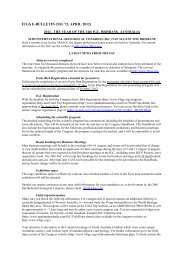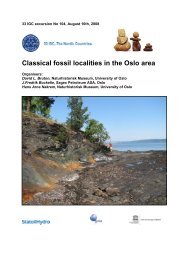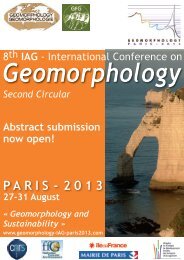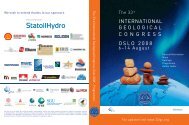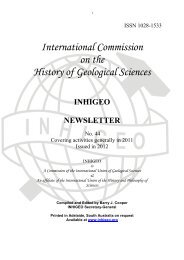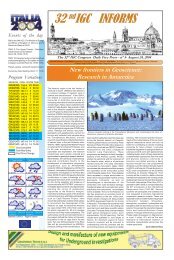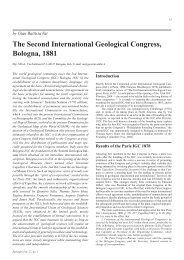Create successful ePaper yourself
Turn your PDF publications into a flip-book with our unique Google optimized e-Paper software.
findings of carbonate rock pebbles and boulders that are unknown in the Kola Peninsula but<br />
typical of the Paleozoic rocks in the northern Russian Platform (Zozulya et al., 2004).<br />
The Podporozh'e horizon overlies the marine and continental sediments of the Mikulinian<br />
(Eemian) Interglacial or the Moscowian (Saalian) till or basement crystalline rocks.<br />
Leningrad (Middle Weichselian) Interstadial Horizon (QBIIIBln, MIS 3)<br />
The deposits of Leningrad Interstadial horizon are known in the central part of the Kola<br />
region from Imandra Lake to Pana Tundra, outcropped in more than ten localities (Lavrova,<br />
1960, Grave et al., 1964, Armand et al, 1969, ets.), in the south-western Murmansk region<br />
(Armand, 1969), in the Terskii Coast of the White Sea (Gudina, Yevzerov, 1981, Korsakova<br />
et al., 2004). As a rule, these deposits are placed between two horizons of Valdaian<br />
(Weichselian) sediments of glacial paragenetic series. They are represented by 2-20-m thick<br />
glaciolacustrine (lgIIIln) and melt-water (fIIIln) sediments (sandy loam, loam, inequigranular<br />
sand with pebble and boulder) in the central part of the Peninsula (Armand et al., 1969), and<br />
by marine (mIIIln), interstadial sediments (mainly by clay, loam, sandy loam with subfossil<br />
mollusk shells and other fossil remnants) with the thickness of 1 m and less in the area of the<br />
Kandalaksha Gulf (Armand et al., 1969; Armand, 1969) and of 2-6 m in the Terskii Coast<br />
(Korsakova et al., 2004). The latter ones were dated using the ESR- and OSL-methods, which<br />
made it possible to specify the geological--stratigraphic position of the interstadial marine<br />
sedimentary units. The obtained geochronological data (approximately 44 and 58 ka) indicate<br />
its Middle Pleniglacial age (MIS 3).<br />
There is an opinion (Yevzerov, Koshechkin, 1980) that the Valdaian (Weichselian) glacial<br />
superhorizon combines sediments of two stages of the glaciation separated by interstadial<br />
deposits. The first stage of the Scandinavian sheet glaciation took place in Early Valdaian<br />
(Weichselian) and corresponds to the MIS 5b, the second one – in Early (partly), Middle and<br />
Late Valdaian (Weichselian) (MIS 2-4). The interstadial warming corresponds to Early<br />
Valdaian (Weichselian) (MIS 5a) and in the Kola region the Middle Valdaian (Weichselian)<br />
interstadial deposits (MIS 3) are not found between horizons of the Scandinavian glaciation<br />
tills as is in the case in northern Finland (Helmens et al., 2000).<br />
Ostashkovian (Late Weichselian) Glacial Horizon (QBIIIBos, MIS 2)<br />
The last glaciation tills and melt-water sediments are the most common in the region. They<br />
are absent only in the Keivy Mnts. (eastern Kola Peninsula), and at the summits of the<br />
mountains and uplands in the central and western parts of the region. In most cases they form<br />
top-section rocks and are rarely overlain by latest lacustrine peat-bog, marine and deluvial<br />
deposits. Till is composed of the diamicton (rubbly silty sands, rubbly sandy loam and loam).<br />
The tills (gIIIos, gaIIIos, gkIIIos) of the Kola region are distinguished by the higher content of<br />
sandy fraction in all the facial varieties. The thickness ranges from tens of centimetres to 30 m<br />
(Armand et al., 1969). The glaciofluvial (fIIIos), glaciolacustrine (lgIIIos) deposits are<br />
throughout confined to the tills of the last glacier. The glaciolacustrine deposits are<br />
represented by varved clay, loam, sandy loam and sand, and the glaciofluvial deposits are<br />
represented by inequigranular sand, gravel and rubbly pebble-bed.<br />
Presently, there are three viewpoints on the evolution of the last glaciation and deglaciation in<br />
the region. According to the first viewpoint the Kola region experienced the Scandinavian icesheet<br />
composed of two flows and numerous lobes. During the late-glacial time the<br />
8



